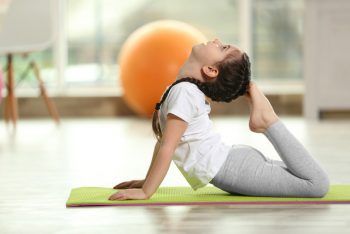Guest writer for Wake Up World
Today’s fast-paced life is not only hard for adults but also throws many challenges at our kids. Children these days deal with stress, distractions, peer pressure, over-stimulation, etc., and for this reason, the low-cost practice of yoga can benefit their well being immensely. Little ones have their own battles, races, and tension, and to bear it all, they require a calm mind and a healthy body.
Yoga has been embraced by adults around the world, giving positive results in reducing stress, improving posture, enhancing mindfulness, and creating a healthier body. Likewise, the therapeutic practice of yoga provides kids with many natural benefits, and prepares them to face the challenges of life, both physically and mentally.
To outline a few, here are 8 amazing benefits of yoga for children:
1. Yoga Improves Concentration
Practicing yoga improves concentration and sensory functioning in both adults and kids. It is great to include yoga practice in a school curriculum to enhance concentration, improve attention, and for promoting positive behavior. Yoga practice session allows kids to have a better focus and they tend to learn things fast. The increased focus, improved concentration, and sustained attention to a task help kids at every stage of their lives. (See: Why We Should Bring Meditation Into Schools.)
2. Yoga Builds Confidence and Self-Esteem
Practicing yoga regularly, learning and mastering new poses and creating a stronger connection between the mind and body, all help in building confidence. Yoga practice also helps them stay persistent and more focused on their goals. This helps them learn the value of every single step they take towards reaching their goals, while fostering a healthy sense of self-improvement and achievement.
3. Yoga Alleviates Stress (Something We All Face)
Stress is not just restricted to adults. Due to an overachieving, competitive and uncertain world of today, kids also have to deal with much stress and tension, and the bustling stride of kids’ lives is affecting their innate happiness and joy. Practicing yoga and breathing techniques work wonderfully in reducing stress and anxiety levels. Like adults, yoga helps kids become calm, relaxed, and encourages self-regulation.
4. Yoga Promotes a Healthy Body and Mind
Daily life and its highs and lows can take a toll on kids’ physical and mental health, but with the help of yoga, they can take far better care of their overall well-being. A regular practice of yoga helps to promote a healthier body and relaxed mind. Yoga asanas stretch, strengthen, and build body coordination. They improve blood flow and promote proper functioning of the internal organs and brain, while cultivating a peaceful, calm, relaxed and integrated state of mind and body.
5. Yoga Teaches Body Balance and Flexibility
Kids are born with natural flexibility, and yoga helps them to maintain and prolong this natural gift into adulthood. Yoga asanas strengthen and tone the body, create body awareness, increase flexibility, balance the body, and also help the kids learn about their body — including its strengths and limitations. All this together forms a good body posture and reduces the risk of injury especially when they playing, engaged in sports, doing any physical activity, and even while walking and running.
6. Yoga Encourages Awareness and Mindfulness
Yoga is an invaluable tool that connects the body, mind and soul together. It also ignites a sense of mindfulness. Yoga teaches present-moment awareness and being mindful to live and enjoy the moment. Yoga let kids know about their bodies, thoughts, and feelings and these things help to create awareness of the body and mind. It helps them create a connection with the self, brings a peace of mind, encourages positivity, and helps them achieve it all.
When kids start living and enjoying the present moment and leaving behind all the worries and tension, they are inclined to become more focused and engaged. A great yoga teacher contributes to a successful accomplishment of yoga session so that kids finish their practice with an aligned, calm, and a happy body and mind. In addition, a great kids’ yoga teacher teaches children about yoga in a way that enables them to can carry this wonderful art of mindfulness and self-healing throughout their life.
7. Yoga Teaches Discipline and Responsibility
Yoga is a lifetime journey and practicing yoga at a young age gives kids a lot of benefits. Yoga fosters discipline and strength; a disciplined lifestyle encourages healthy habits. It makes one aware of what is good and bad for their health and body. When kids learn that lifelong yoga practice contrasts with the gratification of instant achievement, they also learn and accept both bad and good days, and everything in between. Discipline and responsibility also benefit their relationships with their loved ones and the people around them.
8. Yoga Encourages Social Interactions
Yoga is a non-competitive practice and teaches children that successes and failures are a part of life. It teaches that we all are same inside, but our bodies are different. That is why every person takes their own time to master the yoga asanas. The non-competitive social interaction of yoga teaches self-acceptance; yoga makes them fall in love with themselves, and embrace themselves and each other. This encourages them to show gratitude and love to those who are around them and improves their social behavior. Yoga inspires kids to be kind, accepting, patient, and empathetic with their peers and even with themselves.
The Best Yoga Poses for Kids
Introducing and practicing yoga at an early age helps kids build healthy habits and lead a robust lifestyle. Start your kid’s yoga practice with these asanas:
- Vrksasana or Tree Pose
- Tadasana or Mountain Pose
- Setu Bandha Sarvangasana or Bridge Pose
- Adho Mukha Svanasana or Downward Facing Dog Pose
- Ardha Chandrasana or Crescent Moon Pose
- Uttanasana or Standing Forward Bend Pose
- Balasana or Child’s Pose
- Ananda Balasana or Happy Baby Pose
- Baddha Konasana or Butterfly/Cobbler Pose
- Bitilasana Marjaryasana or Cat-Cow Pose
- Savasana or Corpse Pose
Yoga helps the little ones to learn the techniques and importance of self-health and inner-fulfillment. This ‘life science’ encourages them to live a healthy life and develop an intimate relationship with their inner-self. As a parent or a yoga teacher, it is our duty to help our kids explore and create the best world for themselves.
Let the art of yoga be your guide to that!
Related reading:
- Why We Should Bring Meditation Into Schools
- Basic Yoga Moves to Improve Balance, Mood and Flexibility
- Instead of Punishment, This School Teaches Mindfulness and Yoga — With Stunning Results
- Modern Science Confirms Yoga’s Many Health Benefits
- The Breathing Wave: Yoga as Energy Medicine
About the author:
Manmohan Singh is a passionate Yogi, Yoga Teacher and a Traveller in India. He provides yoga teacher training in Rishikesh, India, to spread the message of yogic sciences. His Yoga school, Rishikul Yogshala, imparts teachings on Yoga and Meditation under guided instructions of traditional yoga teachers.
Manmohan loves writing and reading books related to yoga, health, nature and the Himalayas, and believes that “knowledge shared is knowledge gained.”
For more information, visit:

If you've ever found value in our articles, we'd greatly appreciate your support by purchasing Mindful Meditation Techniques for Kids - A Practical Guide for Adults to Empower Kids with the Gift of Inner Peace and Resilience for Life.
In the spirit of mindfulness, we encourage you to choose the paperback version. Delve into its pages away from screen glare and notifications, allowing yourself to fully immerse in the transformative practices within. The physical book enriches the learning process and serves as a tangible commitment to mindfulness, easily shared among family and friends.
Over the past few years, Wake Up World has faced significant online censorship, impacting our financial ability to stay online. Instead of soliciting donations, we're exploring win-win solutions with our readers to remain financially viable. Moving into book publishing, we hope to secure ongoing funds to continue our mission. With over 8,500 articles published in the past 13 years, we are committed to keeping our content free and accessible to everyone, without resorting to a paywall.








